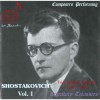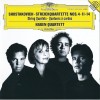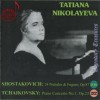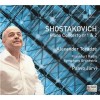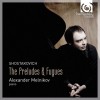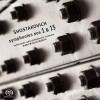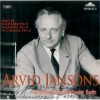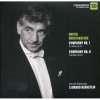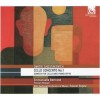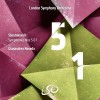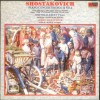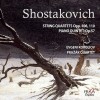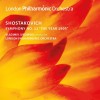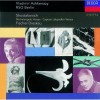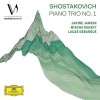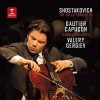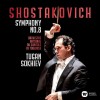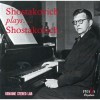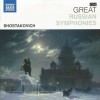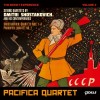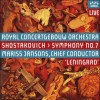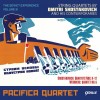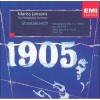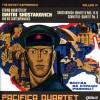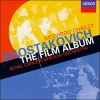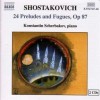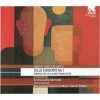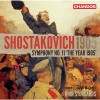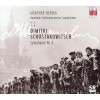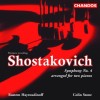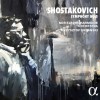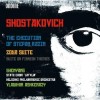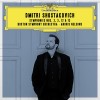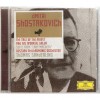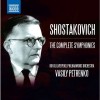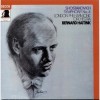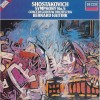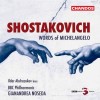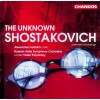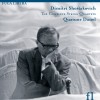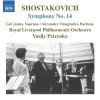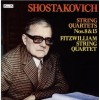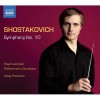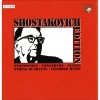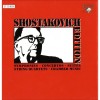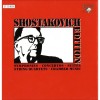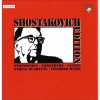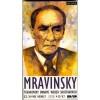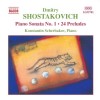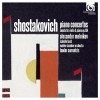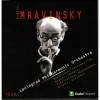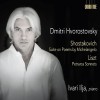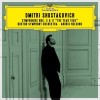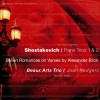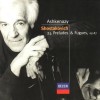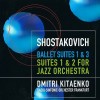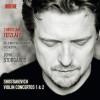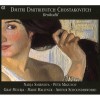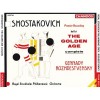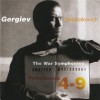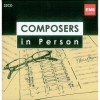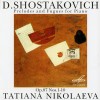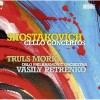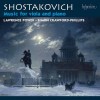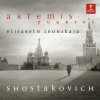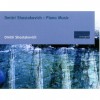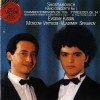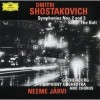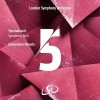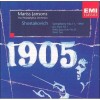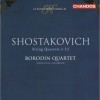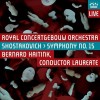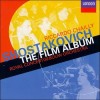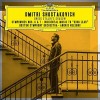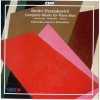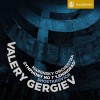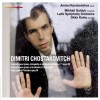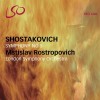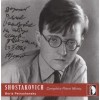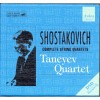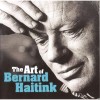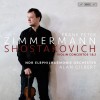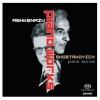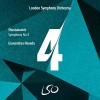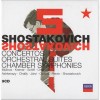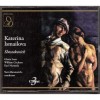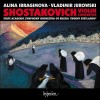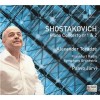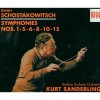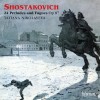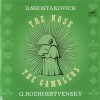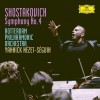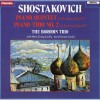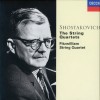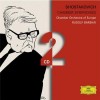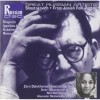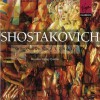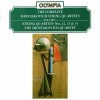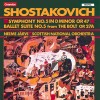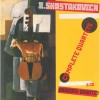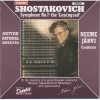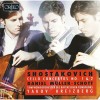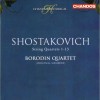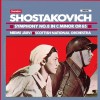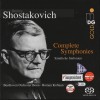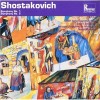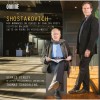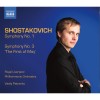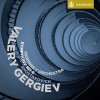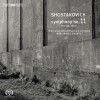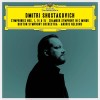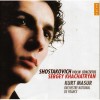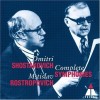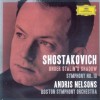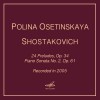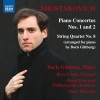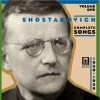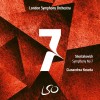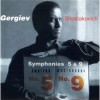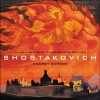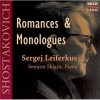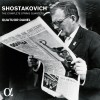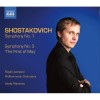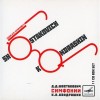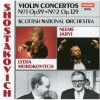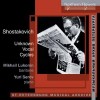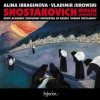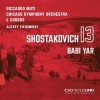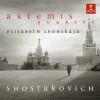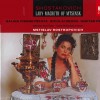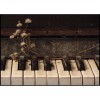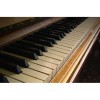Composers
Early life
Born at 2 Podolskaya Ulitsa in Saint Petersburg, Russia, Shostakovich was the second of three children born to Dmitri Boleslavovich Shostakovich and Sofiya Vasilievna Kokoulina. Though the Shostakovich family through his paternal grandfather (originally Szostakowicz) was of Polish Roman Catholic heritage (his family roots trace to the region of the town of Wilejka, now Vileyka in Belarus), his immediate forebears came from Siberia. His paternal grandfather, a Polish revolutionary in the January Uprising of 1863-4, had been exiled to Narim (near Tomsk) in 1866 in the crackdown that followed Dmitri Karakozov's assassination attempt on Tsar Alexander II. When his term of exile ended Bolesław Szostakowicz decided to remain in Siberia. He eventually became a successful banker in Irkutsk and raised a large family. His son, Dmitriy Boleslavovich Shostakovich, the composer's father, was born in exile in Narim in 1875 and attended Saint Petersburg University, graduating in 1899 from the faculty of physics and mathematics. After graduation, he went to work as an engineer under Dmitriy Mendeleyev at the Bureau of Weights and Measures in Saint Petersburg. In 1903, he married Sofiya Vasilievna Kokoulina, another Siberian transplant to the capital. Sofiya herself was one of six children born to Vasiliy Yakovlevich Kokoulin, a Russian Siberian native. Dmitri Shostakovich's family was politically liberal (one of his uncles was a Bolshevik, but the family also sheltered far-right activists).
He was a child prodigy as both a pianist and composer, his talent becoming apparent after he began piano lessons with his mother at the age of eight. (On several occasions, he displayed a remarkable ability to remember what his mother had played at the previous lesson, and would get "caught in the act" of pretending to read, by playing the previous lesson's music when different music was placed in front of him.) In 1918, he wrote a funeral march in memory of two leaders of the Kadet party, murdered by Bolshevik sailors.
In 1919, he was allowed to enter the Petrograd Conservatory, then headed by Alexander Glazunov. Glazunov monitored Shostakovich's progress closely and promoted him. Shostakovich studied piano with Leonid Nikolayev, after a year in the class of Elena Rozanova, composition with Maximilian Steinberg, and counterpoint and fugue with Nikolay Sokolov, with whom he became friends. Shostakovich also attended Alexander Ossovsky's history of music classes. However, he suffered for his perceived lack of political zeal, and initially failed his exam in Marxist methodology in 1926. His first major musical achievement was the First Symphony (premiered 1926), written as his graduation piece at the age of twenty.
After graduation, he initially embarked on a dual career as concert pianist and composer, but his dry style of playing (Fay comments on his "emotional restraint" and "riveting rhythmic drive") was often unappreciated. He nevertheless won an "honorable mention" at the First International Frederic Chopin Piano Competition in Warsaw in 1927. After the competition Shostakovich met the conductor Bruno Walter, who was so impressed by the composer's First Symphony that he conducted it at the Berlin premiere later that year. Thereafter, Shostakovich concentrated on composition and soon limited performances primarily to those of his own works. In 1927 he wrote his Second Symphony (subtitled To October). While writing the symphony, he also began his satirical opera The Nose, based on the story by Gogol. In 1929, the opera was criticised as "formalist" by RAPM, the Stalinist musicians' organisation, and it opened to generally poor reviews in 1930.
1927 also marked the beginning of the composer's relationship with Ivan Sollertinsky, who remained his closest friend until the latter's death in 1944. Sollertinsky introduced Shostakovich to the music of Gustav Mahler, which had a strong influence on his music from the Fourth Symphony onwards. 1932 saw his open marriage to his first wife, Nina Varzar. Initial difficulties led to divorce proceedings in 1935, but the couple soon reunited.
In the late 1920s and early '30s he worked at TRAM, a proletarian youth theatre. Although he did little work in this post, it shielded him from ideological attack. Much of this period was spent writing his opera Lady Macbeth of the Mtsensk District; it was first performed in 1934 and was immediately successful, both on a popular and official level. It was said to be “the result of the general success of Socialist construction, of the correct policy of the Party" and that such an opera “could have been written only by a Soviet composer brought up in the best tradition of Soviet culture.”
First denunciation
In 1936 Shostakovich fell from grace. The year began with a series of attacks on him in Pravda, in particular an article entitled Muddle Instead of Music. The campaign, which condemned Lady Macbeth as formalist, "coarse, primitive and vulgar," was thought to have been instigated by Stalin; consequently, commissions began to dry up, and his income fell by about three quarters. The Fourth Symphony entered rehearsals that December, but the political climate made performance impossible. It was not performed until 1961, but Shostakovich did not repudiate the work: it retained its designation as his Fourth Symphony. A piano reduction was published in 1946.
More widely, 1936 marked the beginning of the Great Terror, in which many of the composer's friends and relatives were imprisoned or killed. His only consolation in this period was the birth of his daughter Galina in 1936; his son Maxim was born two years later.
The composer's response to his denunciation was the Fifth Symphony of 1937, which was, because of its fourth movement, musically more conservative than his earlier works. It was a success, and is still one of his most popular works. It was also at this time that Shostakovich composed the first of his string quartets. His chamber works allowed him to experiment and express ideas which would have been unacceptable in his more public symphonic pieces. In September 1937, he began to teach composition at the Conservatory, which provided some financial security but interfered with his own creative work.
War
After the outbreak of war between the Soviet Union and Germany in 1941, Shostakovich initially remained in Leningrad, enduring the siege, during which he wrote the first three movements of his Seventh Symphony (nicknamed Leningrad). He also contributed to propaganda efforts, posing as a fire warden and delivering a radio broadcast to the Soviet people ShostakovichRadio1941.ogg listen (help·info). In October 1941, the composer and his family evacuated to Kuybishev (now Samara), where the symphony was completed. It was adopted as a symbol of Russian resistance both in the USSR and in the West.
In spring 1943 the family moved to Moscow. Whilst the Seventh Symphony depicts a heroic (and ultimately victorious) struggle against adversity, the Eighth Symphony of that year is perhaps the ultimate in sombre and violent expression within Shostakovich's output, resulting in it being banned until 1956. The Ninth Symphony (1945), in contrast, is an ironic Haydnesque parody, which failed to satisfy demands for a "hymn of victory." Shostakovich continued to compose chamber music, notably his Second Piano Trio (Op. 67), dedicated to the memory of Sollertinsky, with a bitter-sweet, Jewish-themed totentanz finale.
Second denunciation
In 1948 Shostakovich, along with many other composers, was again denounced for formalism in the Zhdanov decree. Most of his works were banned, he was forced to publicly repent, and his family had privileges withdrawn. Yuri Lyubimov says that at this time "he waited for his arrest at night out on the landing by the lift, so that at least his family wouldn't be disturbed."
In the next few years his compositions were divided into film music to pay the rent, official works aimed at securing official rehabilitation, and serious works "for the desk drawer". The latter included the Violin Concerto No. 1 and the song cycle From Jewish Folk Poetry. The cycle was written at a time when the post-war anti-Semitic campaign was already under way, and Shostakovich had close ties with some of those affected.
The restrictions on Shostakovich's music and living arrangements were eased in 1949, in order to secure his participation in a delegation of Soviet notables to the U.S. That year he also wrote his cantata Song of the Forests, which praised Stalin as the "great gardener." In 1951 the composer was made a deputy to the Supreme Soviet of RSFSR. Stalin's death in 1953 was the biggest step towards Shostakovich's official rehabilitation, which was marked by his Tenth Symphony. It features a number of musical quotations and codes (notably the DSCH and Elmira motifs), the meaning of which is still debated, whilst the savage second movement is said to be a musical portrait of Stalin himself. It ranks alongside the Fifth as one of his most popular works. 1953 also saw a stream of premieres of the "desk drawer" works.
During the forties and fifties Shostakovich had close relationships with two of his pupils: Galina Ustvolskaya and Elmira Nazirova. He taught Ustvolskaya from 1937 to 1947. The nature of their relationship is far from clear: Mstislav Rostropovich described it as "tender" and Ustvolskaya claimed in a 1995 interview that she rejected a proposal from him in the fifties. However, in the same interview, Ustvolskaya's friend, Viktor Suslin, said that she had been "deeply disappointed" in him by the time of her graduation in 1947. The relationship with Nazirova seems to have been one-sided, expressed largely through his letters to her, and can be dated to around 1953 to 1956. In the background to all this remained Shostakovich's first, open marriage to Nina Varzar until her death in 1954. He married his second wife, Komsomol activist Margarita Kainova, in 1956; the couple proved ill-matched, and divorced three years later.
In 1954, Shostakovich wrote the Festive Overture, opus 96, that was used as the theme music of the 1980 Summer Olympics. In addition his '"Theme from the film 'Pirogov', Opus 76a: Finale" was played as the cauldron was lit at the 2004 Summer Olympics in Athens, Greece.
In 1959, Shostakovich appeared on stage in Moscow at the end of a concert performance of his Fifth Symphony, congratulating Leonard Bernstein and the New York Philharmonic Orchestra for their performance (part of a concert tour of the Soviet Union). Bernstein recorded the symphony later that year in New York for Columbia Records.
Joining the Party
The year 1960 marked another turning point in Shostakovich's life: his joining of the Communist Party. This event has been interpreted variously as a show of commitment, a mark of cowardice, or as the result of political pressure. On the one hand, the apparat was undoubtedly less repressive than it had been prior to Stalin's death. On the other, his son recalled that the event reduced Shostakovich to tears, and he later told his wife Irina that he had been blackmailed. Lev Lebedinsky has said that the composer was suicidal. Around this time, his health also began to deteriorate. Shostakovich's musical response to these personal crises was the Eighth String Quartet, composed in only three days. Like the Tenth Symphony, this quartet incorporates quotations and his musical monogram.
In 1962 he married for the third time, to Irina Supinskaya. In a letter to his friend Isaak Glikman, he wrote, "her only defect is that she is 27 years old. In all other respects she is splendid: clever, cheerful, straightforward and very likeable." According to Galina Vishnevskaya, who knew the Shostakoviches well, this marriage was a very happy one: "It was with her that Dmitri Dmitriyevich finally came to know domestic peace... Surely, she prolonged his life by several years." In November Shostakovich made his only venture into conducting, conducting a couple of his own works in Gorky: otherwise he declined to conduct, citing nerves and ill health as his reasons.
That year saw Shostakovich again turn to the subject of anti-Semitism in his Thirteenth Symphony (subtitled Babi Yar). The symphony sets a number of poems by Yevgeny Yevtushenko, the first of which commemorates a massacre of the Jews during the Second World War. Opinions are divided as to how great a risk this was: the poem had been published in Soviet media, and was not banned, but it remained controversial. After the symphony's premiere, Yevtushenko was forced to add a stanza to his poem which said that Russians and Ukrainians had died alongside the Jews at Babi Yar.
In 1965 Shostakovich raised his voice in defense of poet Joseph Brodsky, who was unfairly sentenced to five years of exile and hard labor. Shostakovich co-signed protests together with Yevtushenko and fellow Soviet artists Kornei Chukovsky, Anna Akhmatova, Samuil Marshak, and the French philosopher Jean-Paul Sartre. After the protests the sentence was commuted, and Brodsky returned to Leningrad. At that time Shostakovich joined the group of 25 distinguished intellectuals in signing the letter to Leonid Brezhnev asking not to rehabilitate Stalin.
Later life
In later life, Shostakovich suffered from chronic ill health, but he resisted giving up cigarettes and vodka. Beginning in 1958 he suffered from a debilitating condition that particularly affected his right hand, eventually forcing him to give up piano playing; in 1965 it was diagnosed as polio. He also suffered heart attacks the following year and again in 1971, and several falls in which he broke both his legs; in 1967 he wrote in a letter:
"Target achieved so far: 75% (right leg broken, left leg broken, right hand defective. All I need to do now is wreck the left hand and then 100% of my extremities will be out of order.)"
A preoccupation with his own mortality permeates Shostakovich's later works, among them the later quartets and the Fourteenth Symphony of 1969 (a song cycle based on a number of poems on the theme of death). This piece also finds Shostakovich at his most extreme in terms of musical language, with twelve-tone themes being used throughout as well as dense polyphony. Shostakovich dedicated this score to his close friend Benjamin Britten, who conducted its Western premiere at the 1970 Aldeburgh Festival. The Fifteenth Symphony of 1971 is, by contrast, melodic and retrospective in nature, quoting from Wagner, Rossini and the composer's own Fourth Symphony.
Shostakovich died of lung cancer on 9 August 1975 and after a civic funeral was interred in the Novodevichy Cemetery, Moscow. The official obituary did not appear in Pravda until three days after his death, apparently because the wording had to be approved at the highest level, by Brezhnev and the rest of the Politburo. Even before his death he had been commemorated with the naming of the Shostakovich Peninsula on Alexander Island, Antarctica.
He was survived by his third wife Irina, his daughter Galina, and his son Maxim, a pianist and conductor who was the dedicatee and first performer of some of his father's works. Shostakovich himself left behind several recordings of his own piano works, while other noted interpreters of his music include his friends Emil Gilels, Mstislav Rostropovich, Tatiana Nikolayeva, Maria Yudina, David Oistrakh, and members of the Beethoven Quartet.
Shostakovich's opera Orango (1932) was found by Russian researcher Olga Digonskaya in his last home. It is being orchestrated by the British composer Gerard McBurney and will be performed some time in 2010-2011.
Shostakovich's musical influence on later composers outside the former Soviet Union has been relatively slight, although Alfred Schnittke took up his eclecticism, and his contrasts between the dynamic and the static, and some of André Previn's music shows clear links to Shostakovich's style of orchestration. His influence can also be seen in some Nordic composers, such as Kalevi Aho and Lars-Erik Larsson. Many of his Russian contemporaries, and his pupils at the Leningrad Conservatory, however, were strongly influenced by his style (including German Okunev, Boris Tishchenko, whose 5th Symphony of 1978 is dedicated to Shostakovich's memory, Sergei Slonimsky, and others). Shostakovich's conservative idiom has nonetheless grown increasingly popular with audiences both within and beyond Russia, as the avant-garde has declined in influence and debate about his political views has developed.
Works
For a complete list, see List of compositions by Dmitri Shostakovich. See also: Category:Compositions by Dmitri Shostakovich (thematical selection of works by Shostakovich).
Shostakovich's works are broadly tonal and in the Romantic tradition, but with elements of atonality and chromaticism. In some of his later works (e.g. the Twelfth Quartet), he made use of tone rows. His output is dominated by his cycles of symphonies and string quartets, fifteen of each. The symphonies are distributed fairly evenly throughout his career, while the quartets are concentrated towards the latter part. Among the most popular are the Fifth, Seventh and Tenth Symphonies and the Eighth and Fifteenth Quartets. Other works include the operas Lady Macbeth of Mtsensk, The Nose and the unfinished The Gamblers based on the comedy of Nikolai Gogol; six concertos (two each for piano, violin and cello); two piano trios; and a large quantity of film music.
Shostakovich's music shows the influence of many of the composers he most admired: Bach in his fugues and passacaglias; Beethoven in the late quartets; Mahler in the symphonies and Berg in his use of musical codes and quotations. Among Russian composers, he particularly admired Modest Mussorgsky, whose operas Boris Godunov and Khovanshchina he re-orchestrated; Mussorgsky's influence is most prominent in the wintry scenes of Lady Macbeth and the Eleventh Symphony, as well as in his satirical works such as "Rayok". Prokofiev's influence is most apparent in the earlier piano works, such as the first sonata and first concerto. The influence of Russian church and folk music is very evident in his works for unaccompanied choir of the 1950s.
Shostakovich's relationship with Stravinsky was profoundly ambivalent; as he wrote to Glikman, "Stravinsky the composer I worship. Stravinsky the thinker I despise." He was particularly enamoured of the Symphony of Psalms, presenting a copy of his own piano version of it to Stravinsky when the latter visited the USSR in 1962. (The meeting of the two composers was not a great success, however; observers commented on Shostakovich's extreme nervousness and Stravinsky's "cruelty" towards him.)
Many commentators have noted the disjunction between the experimental works before the 1936 denunciation and the more conservative ones which followed; the composer told Flora Litvinova, "without 'Party guidance' … I would have displayed more brilliance, used more sarcasm, I could have revealed my ideas openly instead of having to resort to camouflage." Articles published by Shostakovich in 1934 and 1935 cited Berg, Schoenberg, Krenek, Hindemith, "and especially Stravinsky" among his influences. Key works of the earlier period are the First Symphony, which combined the academicism of the conservatory with his progressive inclinations; The Nose ("The most uncompromisingly modernist of all his stage-works"); Lady Macbeth. which precipitated the denunciation; and the Fourth Symphony, described by Grove as "a colossal synthesis of Shostakovich's musical development to date". The Fourth Symphony was also the first in which the influence of Mahler came to the fore, prefiguring the route Shostakovich was to take to secure his rehabilitation, while he himself admitted that the preceding two were his least successful.
In the years after 1936, Shostakovich's symphonic works were outwardly musically conservative, regardless of any subversive political content. During this time he turned increasingly to chamber works, a field which permitted the composer to explore different and often darker ideas that did not, however, invite external scrutiny. While his chamber works were largely tonal, they gave Shostakovich an outlet for sombre reflection which was not welcomed in his more public works. This is most apparent in the late chamber works, which portray what Groves has described as a "world of purgatorial numbness"; in some of these he included the use of tone rows, although he treated these as melodic themes rather than serially. Vocal works are also a prominent feature of his late output, setting texts often concerned with love, death and art.
Criticism
According to Shostakovich scholar Gerard McBurney, opinion is divided on whether his music is "of visionary power and originality, as some maintain, or, as others think, derivative, trashy, empty and second-hand." William Walton, his British contemporary, described him as "The greatest composer of the 20th century." Musicologist David Fanning concludes in Grove that, "Amid the conflicting pressures of official requirements, the mass suffering of his fellow countrymen, and his personal ideals of humanitarian and public service, he succeeded in forging a musical language of colossal emotional power."
Some modern composers have been critical. Pierre Boulez dismissed Shostakovich's music as "the second, or even third pressing of Mahler." The Romanian composer and Webern disciple Philip Gershkovich called Shostakovich "a hack in a trance." A related complaint is that Shostakovich's style is vulgar and strident: Stravinsky wrote of Lady Macbeth: "brutally hammering … and monotonous." English composer and musicologist Robin Holloway described his music as "battleship-grey in melody and harmony, factory-functional in structure; in content all rhetoric and coercion."
It is certainly true that Shostakovich borrows extensively from the material and styles both of earlier composers and of popular music; the vulgarity of "low" music is a notable influence on this "greatest of eclectics". McBurney traces this to the avant-garde artistic circles of the early Soviet period in which Shostakovich moved early in his career, and argues that these borrowings were a deliberate technique to allow him to create "patterns of contrast, repetition, exaggeration" that gave his music the large-scale structure it required.
The Trotskyist theoretician Alan Woods puts much of this criticism down to anti-communist politicking and the professional jealousy of less accomplished composers, pointing out that Shostakovich "made no secret of his debt to Mahler and many other composers: Bach, Stravinsky, jazz and popular music, Jewish and Russian folk music. But was the music of Beethoven not rooted in the music of Mozart and Haydn? Of course it was. But did it not evolve into something entirely different - something that is unmistakably Beethoven? Of course, it did. And who can deny that the symphonies of Shostakovich, taking their starting point from Mahler, developed into an entirely different musical idiom that is unmistakably Shostakovich and nobody else but Shostakovich?"
Personality
Shostakovich was in many ways an obsessive man: according to his daughter he was "obsessed with cleanliness"; he synchronised the clocks in his apartment; he regularly sent cards to himself to test how well the postal service was working. Wilson's Shostakovich: A Life Remembered indexes 26 references to his nervousness. Even as a young man, Mikhail Druskin remembers that the composer was "fragile and nervously agile". Yuri Lyubimov comments, "The fact that he was more vulnerable and receptive than other people was no doubt an important feature of his genius". In later life, Krzysztof Meyer recalled, "his face was a bag of tics and grimaces". In his lighter moods, sport was one of his main recreations, although he preferred spectating or umpiring to participating (he was a qualified football referee). His favourite football club was Zenit Leningrad, which he would watch regularly. He also enjoyed playing card games, particularly patience. Both light and dark sides of his character were evident in his fondness for satirical writers such as Gogol, Chekhov and Mikhail Zoshchenko. The influence of the latter in particular is evident in his letters, which include wry parodies of Soviet officialese. Zoshchenko himself noted the contradictions in the composer's character: "he is … frail, fragile, withdrawn, an infinitely direct, pure child … [but he is also] hard, acid, extremely intelligent, strong perhaps, despotic and not altogether good-natured (although cerebrally good-natured)".
He was diffident by nature: Flora Litvinova has said he was "completely incapable of saying 'No' to anybody." This meant he was easily persuaded to sign official statements, including a denunciation of Andrei Sakharov in 1973; on the other hand he was willing to try to help constituents in his capacities as chairman of the Composers' Union and Deputy to the Supreme Soviet. Oleg Prokofiev commented that "he tried to help so many people that … less and less attention was paid to his pleas."
Orthodoxy and revisionism
Shostakovich's response to official criticism and, more importantly, the question of whether he used music as a kind of abstract dissidence is a matter of dispute. It is clear that outwardly he conformed to government policies and positions, reading speeches and putting his name to articles expressing the government line. It is also generally agreed that he disliked many aspects of the regime, a view confirmed by his family, his letters to Isaak Glikman, and the satirical cantata "Rayok," which ridiculed the "anti-formalist" campaign and was kept hidden until after his death. He was a close friend of Trotsky's protege Marshal of the Soviet Union Mikhail Tukhachevsky, who was executed in 1937 for his opposition to Stalin.
It is also uncertain to what extent Shostakovich expressed his opposition to the state in his music. The revisionist view was put forth by Solomon Volkov in the 1979 book Testimony, which was claimed to be Shostakovich's memoirs dictated to Volkov. The book alleged that many of the composer's works contained coded anti-government messages. That would place Shostakovich in a tradition of Russian artists outwitting censorship that goes back at least to the early 19th century poet Pushkin. It is known that he incorporated many quotations and motifs in his work, most notably his signature DSCH theme. His longtime collaborator Evgeny Mravinsky said that "Shostakovich very often explained his intentions with very specific images and connotations." The revisionist perspective has subsequently been supported by his children, Maxim and Galina, and many Russian musicians. More recently, Volkov has argued that Shostakovich adopted the role of the yurodivy or holy fool in his relations with the government. Shostakovich's widow Irina, who was present during Volkov's visits to Shostakovich, denies the authenticity of Testimony. Other prominent revisionists are Ian MacDonald, whose book The New Shostakovich put forward more interpretations of his music, and Elizabeth Wilson, whose Shostakovich: A Life Remembered provides testimony from many of the composer's acquaintances.
Many musicians and scholars (notably Laurel Fay and Richard Taruskin) contest the authenticity (and debate the significance) of Testimony, alleging that Volkov compiled it from a combination of recycled articles, gossip, and possibly some information direct from the composer. Fay substantiates these allegations in her 2002 article 'Volkov's Testimony reconsidered', showing that the only pages of the original Testimony manuscript that Shostakovich had signed and verified are in fact word-for-word reproductions of earlier interviews given by the composer, none of which are controversial. (Against this, it has been pointed out by Allan B. Ho and Dmitry Feofanov that at least two of the signed pages contain controversial material: for instance, "on the first page of chapter 3, where Shostakovich notes that the plaque that reads 'In this house lived Meyerhold' should also say 'And in this house his wife was brutally murdered'.") More broadly, Fay and Taruskin argue that the significance of Shostakovich is in his music rather than his life, and that to seek political messages in the music detracts from, rather than enhances, its artistic value.
Recently Added
Biography
Early life
Born at 2 Podolskaya Ulitsa in Saint Petersburg, Russia, Shostakovich was the second of three children born to Dmitri Boleslavovich Shostakovich and Sofiya Vasilievna Kokoulina. Though the Shostakovich family through his paternal grandfather (originally Szostakowicz) was of Polish Roman Catholic heritage (his family roots trace to the region of the town of Wilejka, now Vileyka in Belarus), his immediate forebears came from Siberia. His paternal grandfather, a Polish revolutionary in the January Uprising of 1863-4, had been exiled to Narim (near Tomsk) in 1866 in the crackdown that followed Dmitri Karakozov's assassination attempt on Tsar Alexander II. When his term of exile ended Bolesław Szostakowicz decided to remain in Siberia. He eventually became a successful banker in Irkutsk and raised a large family. His son, Dmitriy Boleslavovich Shostakovich, the composer's father, was born in exile in Narim in 1875 and attended Saint Petersburg University, graduating in 1899 from the faculty of physics and mathematics. After graduation, he went to work as an engineer under Dmitriy Mendeleyev at the Bureau of Weights and Measures in Saint Petersburg. In 1903, he married Sofiya Vasilievna Kokoulina, another Siberian transplant to the capital. Sofiya herself was one of six children born to Vasiliy Yakovlevich Kokoulin, a Russian Siberian native. Dmitri Shostakovich's family was politically liberal (one of his uncles was a Bolshevik, but the family also sheltered far-right activists).
He was a child prodigy as both a pianist and composer, his talent becoming apparent after he began piano lessons with his mother at the age of eight. (On several occasions, he displayed a remarkable ability to remember what his mother had played at the previous lesson, and would get "caught in the act" of pretending to read, by playing the previous lesson's music when different music was placed in front of him.) In 1918, he wrote a funeral march in memory of two leaders of the Kadet party, murdered by Bolshevik sailors.
In 1919, he was allowed to enter the Petrograd Conservatory, then headed by Alexander Glazunov. Glazunov monitored Shostakovich's progress closely and promoted him. Shostakovich studied piano with Leonid Nikolayev, after a year in the class of Elena Rozanova, composition with Maximilian Steinberg, and counterpoint and fugue with Nikolay Sokolov, with whom he became friends. Shostakovich also attended Alexander Ossovsky's history of music classes. However, he suffered for his perceived lack of political zeal, and initially failed his exam in Marxist methodology in 1926. His first major musical achievement was the First Symphony (premiered 1926), written as his graduation piece at the age of twenty.
After graduation, he initially embarked on a dual career as concert pianist and composer, but his dry style of playing (Fay comments on his "emotional restraint" and "riveting rhythmic drive") was often unappreciated. He nevertheless won an "honorable mention" at the First International Frederic Chopin Piano Competition in Warsaw in 1927. After the competition Shostakovich met the conductor Bruno Walter, who was so impressed by the composer's First Symphony that he conducted it at the Berlin premiere later that year. Thereafter, Shostakovich concentrated on composition and soon limited performances primarily to those of his own works. In 1927 he wrote his Second Symphony (subtitled To October). While writing the symphony, he also began his satirical opera The Nose, based on the story by Gogol. In 1929, the opera was criticised as "formalist" by RAPM, the Stalinist musicians' organisation, and it opened to generally poor reviews in 1930.
1927 also marked the beginning of the composer's relationship with Ivan Sollertinsky, who remained his closest friend until the latter's death in 1944. Sollertinsky introduced Shostakovich to the music of Gustav Mahler, which had a strong influence on his music from the Fourth Symphony onwards. 1932 saw his open marriage to his first wife, Nina Varzar. Initial difficulties led to divorce proceedings in 1935, but the couple soon reunited.
In the late 1920s and early '30s he worked at TRAM, a proletarian youth theatre. Although he did little work in this post, it shielded him from ideological attack. Much of this period was spent writing his opera Lady Macbeth of the Mtsensk District; it was first performed in 1934 and was immediately successful, both on a popular and official level. It was said to be “the result of the general success of Socialist construction, of the correct policy of the Party" and that such an opera “could have been written only by a Soviet composer brought up in the best tradition of Soviet culture.”
First denunciation
In 1936 Shostakovich fell from grace. The year began with a series of attacks on him in Pravda, in particular an article entitled Muddle Instead of Music. The campaign, which condemned Lady Macbeth as formalist, "coarse, primitive and vulgar," was thought to have been instigated by Stalin; consequently, commissions began to dry up, and his income fell by about three quarters. The Fourth Symphony entered rehearsals that December, but the political climate made performance impossible. It was not performed until 1961, but Shostakovich did not repudiate the work: it retained its designation as his Fourth Symphony. A piano reduction was published in 1946.
More widely, 1936 marked the beginning of the Great Terror, in which many of the composer's friends and relatives were imprisoned or killed. His only consolation in this period was the birth of his daughter Galina in 1936; his son Maxim was born two years later.
The composer's response to his denunciation was the Fifth Symphony of 1937, which was, because of its fourth movement, musically more conservative than his earlier works. It was a success, and is still one of his most popular works. It was also at this time that Shostakovich composed the first of his string quartets. His chamber works allowed him to experiment and express ideas which would have been unacceptable in his more public symphonic pieces. In September 1937, he began to teach composition at the Conservatory, which provided some financial security but interfered with his own creative work.
War
After the outbreak of war between the Soviet Union and Germany in 1941, Shostakovich initially remained in Leningrad, enduring the siege, during which he wrote the first three movements of his Seventh Symphony (nicknamed Leningrad). He also contributed to propaganda efforts, posing as a fire warden and delivering a radio broadcast to the Soviet people ShostakovichRadio1941.ogg listen (help·info). In October 1941, the composer and his family evacuated to Kuybishev (now Samara), where the symphony was completed. It was adopted as a symbol of Russian resistance both in the USSR and in the West.
In spring 1943 the family moved to Moscow. Whilst the Seventh Symphony depicts a heroic (and ultimately victorious) struggle against adversity, the Eighth Symphony of that year is perhaps the ultimate in sombre and violent expression within Shostakovich's output, resulting in it being banned until 1956. The Ninth Symphony (1945), in contrast, is an ironic Haydnesque parody, which failed to satisfy demands for a "hymn of victory." Shostakovich continued to compose chamber music, notably his Second Piano Trio (Op. 67), dedicated to the memory of Sollertinsky, with a bitter-sweet, Jewish-themed totentanz finale.
Second denunciation
In 1948 Shostakovich, along with many other composers, was again denounced for formalism in the Zhdanov decree. Most of his works were banned, he was forced to publicly repent, and his family had privileges withdrawn. Yuri Lyubimov says that at this time "he waited for his arrest at night out on the landing by the lift, so that at least his family wouldn't be disturbed."
In the next few years his compositions were divided into film music to pay the rent, official works aimed at securing official rehabilitation, and serious works "for the desk drawer". The latter included the Violin Concerto No. 1 and the song cycle From Jewish Folk Poetry. The cycle was written at a time when the post-war anti-Semitic campaign was already under way, and Shostakovich had close ties with some of those affected.
The restrictions on Shostakovich's music and living arrangements were eased in 1949, in order to secure his participation in a delegation of Soviet notables to the U.S. That year he also wrote his cantata Song of the Forests, which praised Stalin as the "great gardener." In 1951 the composer was made a deputy to the Supreme Soviet of RSFSR. Stalin's death in 1953 was the biggest step towards Shostakovich's official rehabilitation, which was marked by his Tenth Symphony. It features a number of musical quotations and codes (notably the DSCH and Elmira motifs), the meaning of which is still debated, whilst the savage second movement is said to be a musical portrait of Stalin himself. It ranks alongside the Fifth as one of his most popular works. 1953 also saw a stream of premieres of the "desk drawer" works.
During the forties and fifties Shostakovich had close relationships with two of his pupils: Galina Ustvolskaya and Elmira Nazirova. He taught Ustvolskaya from 1937 to 1947. The nature of their relationship is far from clear: Mstislav Rostropovich described it as "tender" and Ustvolskaya claimed in a 1995 interview that she rejected a proposal from him in the fifties. However, in the same interview, Ustvolskaya's friend, Viktor Suslin, said that she had been "deeply disappointed" in him by the time of her graduation in 1947. The relationship with Nazirova seems to have been one-sided, expressed largely through his letters to her, and can be dated to around 1953 to 1956. In the background to all this remained Shostakovich's first, open marriage to Nina Varzar until her death in 1954. He married his second wife, Komsomol activist Margarita Kainova, in 1956; the couple proved ill-matched, and divorced three years later.
In 1954, Shostakovich wrote the Festive Overture, opus 96, that was used as the theme music of the 1980 Summer Olympics. In addition his '"Theme from the film 'Pirogov', Opus 76a: Finale" was played as the cauldron was lit at the 2004 Summer Olympics in Athens, Greece.
In 1959, Shostakovich appeared on stage in Moscow at the end of a concert performance of his Fifth Symphony, congratulating Leonard Bernstein and the New York Philharmonic Orchestra for their performance (part of a concert tour of the Soviet Union). Bernstein recorded the symphony later that year in New York for Columbia Records.
Joining the Party
The year 1960 marked another turning point in Shostakovich's life: his joining of the Communist Party. This event has been interpreted variously as a show of commitment, a mark of cowardice, or as the result of political pressure. On the one hand, the apparat was undoubtedly less repressive than it had been prior to Stalin's death. On the other, his son recalled that the event reduced Shostakovich to tears, and he later told his wife Irina that he had been blackmailed. Lev Lebedinsky has said that the composer was suicidal. Around this time, his health also began to deteriorate. Shostakovich's musical response to these personal crises was the Eighth String Quartet, composed in only three days. Like the Tenth Symphony, this quartet incorporates quotations and his musical monogram.
In 1962 he married for the third time, to Irina Supinskaya. In a letter to his friend Isaak Glikman, he wrote, "her only defect is that she is 27 years old. In all other respects she is splendid: clever, cheerful, straightforward and very likeable." According to Galina Vishnevskaya, who knew the Shostakoviches well, this marriage was a very happy one: "It was with her that Dmitri Dmitriyevich finally came to know domestic peace... Surely, she prolonged his life by several years." In November Shostakovich made his only venture into conducting, conducting a couple of his own works in Gorky: otherwise he declined to conduct, citing nerves and ill health as his reasons.
That year saw Shostakovich again turn to the subject of anti-Semitism in his Thirteenth Symphony (subtitled Babi Yar). The symphony sets a number of poems by Yevgeny Yevtushenko, the first of which commemorates a massacre of the Jews during the Second World War. Opinions are divided as to how great a risk this was: the poem had been published in Soviet media, and was not banned, but it remained controversial. After the symphony's premiere, Yevtushenko was forced to add a stanza to his poem which said that Russians and Ukrainians had died alongside the Jews at Babi Yar.
In 1965 Shostakovich raised his voice in defense of poet Joseph Brodsky, who was unfairly sentenced to five years of exile and hard labor. Shostakovich co-signed protests together with Yevtushenko and fellow Soviet artists Kornei Chukovsky, Anna Akhmatova, Samuil Marshak, and the French philosopher Jean-Paul Sartre. After the protests the sentence was commuted, and Brodsky returned to Leningrad. At that time Shostakovich joined the group of 25 distinguished intellectuals in signing the letter to Leonid Brezhnev asking not to rehabilitate Stalin.
Later life
In later life, Shostakovich suffered from chronic ill health, but he resisted giving up cigarettes and vodka. Beginning in 1958 he suffered from a debilitating condition that particularly affected his right hand, eventually forcing him to give up piano playing; in 1965 it was diagnosed as polio. He also suffered heart attacks the following year and again in 1971, and several falls in which he broke both his legs; in 1967 he wrote in a letter:
"Target achieved so far: 75% (right leg broken, left leg broken, right hand defective. All I need to do now is wreck the left hand and then 100% of my extremities will be out of order.)"
A preoccupation with his own mortality permeates Shostakovich's later works, among them the later quartets and the Fourteenth Symphony of 1969 (a song cycle based on a number of poems on the theme of death). This piece also finds Shostakovich at his most extreme in terms of musical language, with twelve-tone themes being used throughout as well as dense polyphony. Shostakovich dedicated this score to his close friend Benjamin Britten, who conducted its Western premiere at the 1970 Aldeburgh Festival. The Fifteenth Symphony of 1971 is, by contrast, melodic and retrospective in nature, quoting from Wagner, Rossini and the composer's own Fourth Symphony.
Shostakovich died of lung cancer on 9 August 1975 and after a civic funeral was interred in the Novodevichy Cemetery, Moscow. The official obituary did not appear in Pravda until three days after his death, apparently because the wording had to be approved at the highest level, by Brezhnev and the rest of the Politburo. Even before his death he had been commemorated with the naming of the Shostakovich Peninsula on Alexander Island, Antarctica.
He was survived by his third wife Irina, his daughter Galina, and his son Maxim, a pianist and conductor who was the dedicatee and first performer of some of his father's works. Shostakovich himself left behind several recordings of his own piano works, while other noted interpreters of his music include his friends Emil Gilels, Mstislav Rostropovich, Tatiana Nikolayeva, Maria Yudina, David Oistrakh, and members of the Beethoven Quartet.
Shostakovich's opera Orango (1932) was found by Russian researcher Olga Digonskaya in his last home. It is being orchestrated by the British composer Gerard McBurney and will be performed some time in 2010-2011.
Shostakovich's musical influence on later composers outside the former Soviet Union has been relatively slight, although Alfred Schnittke took up his eclecticism, and his contrasts between the dynamic and the static, and some of André Previn's music shows clear links to Shostakovich's style of orchestration. His influence can also be seen in some Nordic composers, such as Kalevi Aho and Lars-Erik Larsson. Many of his Russian contemporaries, and his pupils at the Leningrad Conservatory, however, were strongly influenced by his style (including German Okunev, Boris Tishchenko, whose 5th Symphony of 1978 is dedicated to Shostakovich's memory, Sergei Slonimsky, and others). Shostakovich's conservative idiom has nonetheless grown increasingly popular with audiences both within and beyond Russia, as the avant-garde has declined in influence and debate about his political views has developed.
Works
For a complete list, see List of compositions by Dmitri Shostakovich. See also: Category:Compositions by Dmitri Shostakovich (thematical selection of works by Shostakovich).
Shostakovich's works are broadly tonal and in the Romantic tradition, but with elements of atonality and chromaticism. In some of his later works (e.g. the Twelfth Quartet), he made use of tone rows. His output is dominated by his cycles of symphonies and string quartets, fifteen of each. The symphonies are distributed fairly evenly throughout his career, while the quartets are concentrated towards the latter part. Among the most popular are the Fifth, Seventh and Tenth Symphonies and the Eighth and Fifteenth Quartets. Other works include the operas Lady Macbeth of Mtsensk, The Nose and the unfinished The Gamblers based on the comedy of Nikolai Gogol; six concertos (two each for piano, violin and cello); two piano trios; and a large quantity of film music.
Shostakovich's music shows the influence of many of the composers he most admired: Bach in his fugues and passacaglias; Beethoven in the late quartets; Mahler in the symphonies and Berg in his use of musical codes and quotations. Among Russian composers, he particularly admired Modest Mussorgsky, whose operas Boris Godunov and Khovanshchina he re-orchestrated; Mussorgsky's influence is most prominent in the wintry scenes of Lady Macbeth and the Eleventh Symphony, as well as in his satirical works such as "Rayok". Prokofiev's influence is most apparent in the earlier piano works, such as the first sonata and first concerto. The influence of Russian church and folk music is very evident in his works for unaccompanied choir of the 1950s.
Shostakovich's relationship with Stravinsky was profoundly ambivalent; as he wrote to Glikman, "Stravinsky the composer I worship. Stravinsky the thinker I despise." He was particularly enamoured of the Symphony of Psalms, presenting a copy of his own piano version of it to Stravinsky when the latter visited the USSR in 1962. (The meeting of the two composers was not a great success, however; observers commented on Shostakovich's extreme nervousness and Stravinsky's "cruelty" towards him.)
Many commentators have noted the disjunction between the experimental works before the 1936 denunciation and the more conservative ones which followed; the composer told Flora Litvinova, "without 'Party guidance' … I would have displayed more brilliance, used more sarcasm, I could have revealed my ideas openly instead of having to resort to camouflage." Articles published by Shostakovich in 1934 and 1935 cited Berg, Schoenberg, Krenek, Hindemith, "and especially Stravinsky" among his influences. Key works of the earlier period are the First Symphony, which combined the academicism of the conservatory with his progressive inclinations; The Nose ("The most uncompromisingly modernist of all his stage-works"); Lady Macbeth. which precipitated the denunciation; and the Fourth Symphony, described by Grove as "a colossal synthesis of Shostakovich's musical development to date". The Fourth Symphony was also the first in which the influence of Mahler came to the fore, prefiguring the route Shostakovich was to take to secure his rehabilitation, while he himself admitted that the preceding two were his least successful.
In the years after 1936, Shostakovich's symphonic works were outwardly musically conservative, regardless of any subversive political content. During this time he turned increasingly to chamber works, a field which permitted the composer to explore different and often darker ideas that did not, however, invite external scrutiny. While his chamber works were largely tonal, they gave Shostakovich an outlet for sombre reflection which was not welcomed in his more public works. This is most apparent in the late chamber works, which portray what Groves has described as a "world of purgatorial numbness"; in some of these he included the use of tone rows, although he treated these as melodic themes rather than serially. Vocal works are also a prominent feature of his late output, setting texts often concerned with love, death and art.
Criticism
According to Shostakovich scholar Gerard McBurney, opinion is divided on whether his music is "of visionary power and originality, as some maintain, or, as others think, derivative, trashy, empty and second-hand." William Walton, his British contemporary, described him as "The greatest composer of the 20th century." Musicologist David Fanning concludes in Grove that, "Amid the conflicting pressures of official requirements, the mass suffering of his fellow countrymen, and his personal ideals of humanitarian and public service, he succeeded in forging a musical language of colossal emotional power."
Some modern composers have been critical. Pierre Boulez dismissed Shostakovich's music as "the second, or even third pressing of Mahler." The Romanian composer and Webern disciple Philip Gershkovich called Shostakovich "a hack in a trance." A related complaint is that Shostakovich's style is vulgar and strident: Stravinsky wrote of Lady Macbeth: "brutally hammering … and monotonous." English composer and musicologist Robin Holloway described his music as "battleship-grey in melody and harmony, factory-functional in structure; in content all rhetoric and coercion."
It is certainly true that Shostakovich borrows extensively from the material and styles both of earlier composers and of popular music; the vulgarity of "low" music is a notable influence on this "greatest of eclectics". McBurney traces this to the avant-garde artistic circles of the early Soviet period in which Shostakovich moved early in his career, and argues that these borrowings were a deliberate technique to allow him to create "patterns of contrast, repetition, exaggeration" that gave his music the large-scale structure it required.
The Trotskyist theoretician Alan Woods puts much of this criticism down to anti-communist politicking and the professional jealousy of less accomplished composers, pointing out that Shostakovich "made no secret of his debt to Mahler and many other composers: Bach, Stravinsky, jazz and popular music, Jewish and Russian folk music. But was the music of Beethoven not rooted in the music of Mozart and Haydn? Of course it was. But did it not evolve into something entirely different - something that is unmistakably Beethoven? Of course, it did. And who can deny that the symphonies of Shostakovich, taking their starting point from Mahler, developed into an entirely different musical idiom that is unmistakably Shostakovich and nobody else but Shostakovich?"
Personality
Shostakovich was in many ways an obsessive man: according to his daughter he was "obsessed with cleanliness"; he synchronised the clocks in his apartment; he regularly sent cards to himself to test how well the postal service was working. Wilson's Shostakovich: A Life Remembered indexes 26 references to his nervousness. Even as a young man, Mikhail Druskin remembers that the composer was "fragile and nervously agile". Yuri Lyubimov comments, "The fact that he was more vulnerable and receptive than other people was no doubt an important feature of his genius". In later life, Krzysztof Meyer recalled, "his face was a bag of tics and grimaces". In his lighter moods, sport was one of his main recreations, although he preferred spectating or umpiring to participating (he was a qualified football referee). His favourite football club was Zenit Leningrad, which he would watch regularly. He also enjoyed playing card games, particularly patience. Both light and dark sides of his character were evident in his fondness for satirical writers such as Gogol, Chekhov and Mikhail Zoshchenko. The influence of the latter in particular is evident in his letters, which include wry parodies of Soviet officialese. Zoshchenko himself noted the contradictions in the composer's character: "he is … frail, fragile, withdrawn, an infinitely direct, pure child … [but he is also] hard, acid, extremely intelligent, strong perhaps, despotic and not altogether good-natured (although cerebrally good-natured)".
He was diffident by nature: Flora Litvinova has said he was "completely incapable of saying 'No' to anybody." This meant he was easily persuaded to sign official statements, including a denunciation of Andrei Sakharov in 1973; on the other hand he was willing to try to help constituents in his capacities as chairman of the Composers' Union and Deputy to the Supreme Soviet. Oleg Prokofiev commented that "he tried to help so many people that … less and less attention was paid to his pleas."
Orthodoxy and revisionism
Shostakovich's response to official criticism and, more importantly, the question of whether he used music as a kind of abstract dissidence is a matter of dispute. It is clear that outwardly he conformed to government policies and positions, reading speeches and putting his name to articles expressing the government line. It is also generally agreed that he disliked many aspects of the regime, a view confirmed by his family, his letters to Isaak Glikman, and the satirical cantata "Rayok," which ridiculed the "anti-formalist" campaign and was kept hidden until after his death. He was a close friend of Trotsky's protege Marshal of the Soviet Union Mikhail Tukhachevsky, who was executed in 1937 for his opposition to Stalin.
It is also uncertain to what extent Shostakovich expressed his opposition to the state in his music. The revisionist view was put forth by Solomon Volkov in the 1979 book Testimony, which was claimed to be Shostakovich's memoirs dictated to Volkov. The book alleged that many of the composer's works contained coded anti-government messages. That would place Shostakovich in a tradition of Russian artists outwitting censorship that goes back at least to the early 19th century poet Pushkin. It is known that he incorporated many quotations and motifs in his work, most notably his signature DSCH theme. His longtime collaborator Evgeny Mravinsky said that "Shostakovich very often explained his intentions with very specific images and connotations." The revisionist perspective has subsequently been supported by his children, Maxim and Galina, and many Russian musicians. More recently, Volkov has argued that Shostakovich adopted the role of the yurodivy or holy fool in his relations with the government. Shostakovich's widow Irina, who was present during Volkov's visits to Shostakovich, denies the authenticity of Testimony. Other prominent revisionists are Ian MacDonald, whose book The New Shostakovich put forward more interpretations of his music, and Elizabeth Wilson, whose Shostakovich: A Life Remembered provides testimony from many of the composer's acquaintances.
Many musicians and scholars (notably Laurel Fay and Richard Taruskin) contest the authenticity (and debate the significance) of Testimony, alleging that Volkov compiled it from a combination of recycled articles, gossip, and possibly some information direct from the composer. Fay substantiates these allegations in her 2002 article 'Volkov's Testimony reconsidered', showing that the only pages of the original Testimony manuscript that Shostakovich had signed and verified are in fact word-for-word reproductions of earlier interviews given by the composer, none of which are controversial. (Against this, it has been pointed out by Allan B. Ho and Dmitry Feofanov that at least two of the signed pages contain controversial material: for instance, "on the first page of chapter 3, where Shostakovich notes that the plaque that reads 'In this house lived Meyerhold' should also say 'And in this house his wife was brutally murdered'.") More broadly, Fay and Taruskin argue that the significance of Shostakovich is in his music rather than his life, and that to seek political messages in the music detracts from, rather than enhances, its artistic value.
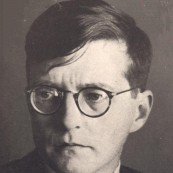














![Piano trios (Gilels, Kogan, Rostropovich) [5 CD]](http://static.classicalm.com/repository/collection-cover/small/219-img1316559969860933.jpg)
![Russian legends - Mstislav Rostropovich [10 CD]](http://static.classicalm.com/repository/collection-cover/small/275-img1319023256353734.jpg)
![Russian legends - Evgeny Kissin [9 CD]](http://static.classicalm.com/repository/collection-cover/small/265-img1318196902541222.jpg)
![Russian legends - David Oistrakh [20 CD]](http://static.classicalm.com/repository/collection-cover/small/267-img1318418713553266.jpg)
![Russian legends - Leonid Kogan [10 CD]](http://static.classicalm.com/repository/collection-cover/small/269-img1318707830156876.jpg)
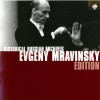
![Russian legends - Viktor Tretiakov [6 CD]](http://static.classicalm.com/repository/collection-cover/small/271-img1318800770253179.jpg)
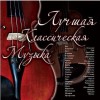
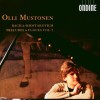
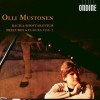




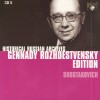
![Great European Organs. 26-Keith John [Gloucester Cathedral]](http://static.classicalm.com/repository/collection-cover/small/891-img1341406805684265.jpg)
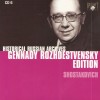
![Russian legends - Daniel Shafran [7 CD]](http://static.classicalm.com/repository/collection-cover/small/277-img1319146356180506.jpg)
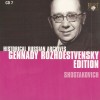
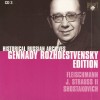
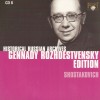
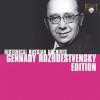


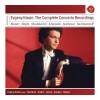
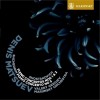
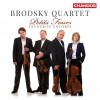
![Martha Argerich and Friends: Live from Lugano 2011 [CD 2 of 3]](http://static.classicalm.com/repository/disk-cover/small/1863-img1344865303495286.jpg)
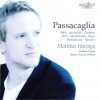
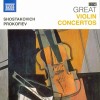
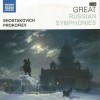
![Martha Argerich Edition - Solos & Duos [CD5of6]](http://static.classicalm.com/repository/disk-cover/small/3585-img1404480174476811.jpg)
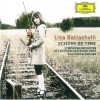
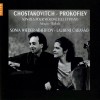
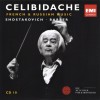
![Martha Argerich Edition: Chamber Music [CD7of8]](http://static.classicalm.com/repository/disk-cover/small/3575-img1404468189742128.jpg)

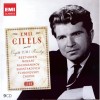
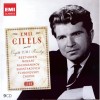
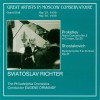
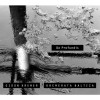


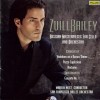
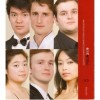
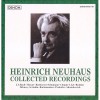
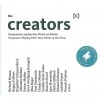
![Martha Argerich - The Collection 2 - The Concerto Recordings [CD6of7]](http://static.classicalm.com/repository/disk-cover/small/3567-img1403955890216033.jpg)
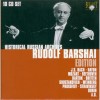
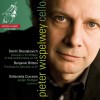
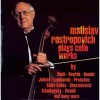
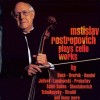
![The 100 Most Beautiful Melodies [CD 2 of 6]](http://static.classicalm.com/repository/disk-cover/small/2911-img1361460313445296.jpg)
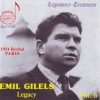
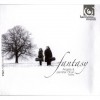
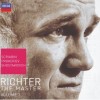
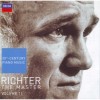
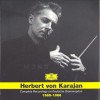
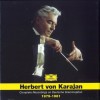
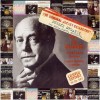
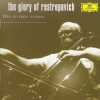
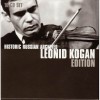
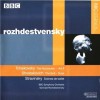


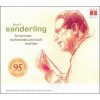
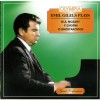
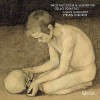
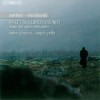
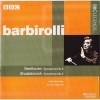
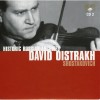
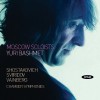
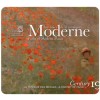
![Anthology of the Royal Concertgebouw Orchestra: Live the Radio Recordings 1960-1970 [CD12]](http://static.classicalm.com/repository/disk-cover/small/3449-img1395225514185949.jpg)

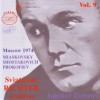
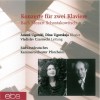
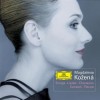
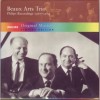

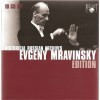
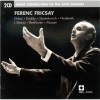
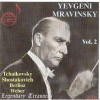
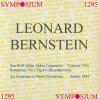
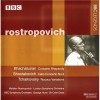
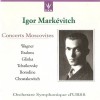
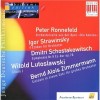
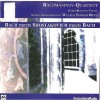
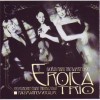
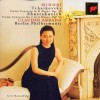
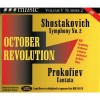
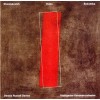
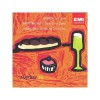
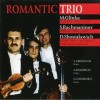
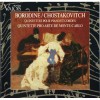
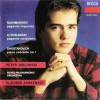
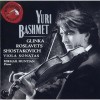
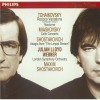
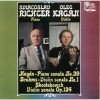
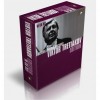
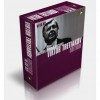
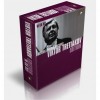


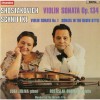
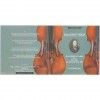
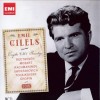
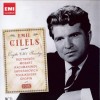
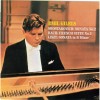

![Richter in Hungary, Volume 3 [2 CD]](http://static.classicalm.com/repository/disk-cover/small/881-img1316377899539479.jpg)
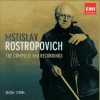
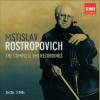
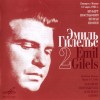
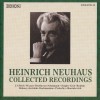
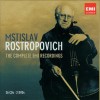
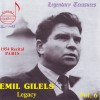
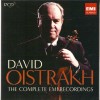
![The Heifetz Collection, Volume 19 [2 CD]](http://static.classicalm.com/repository/disk-cover/small/947-img1317413695600051.jpg)
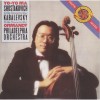
![The Heifetz Collection, Volume 5 [2 CD]](http://static.classicalm.com/repository/disk-cover/small/723-img1315251789683087.jpg)
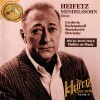
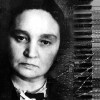
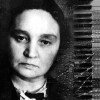
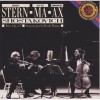
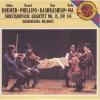
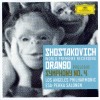
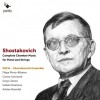
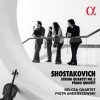
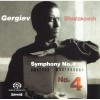
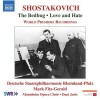
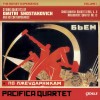
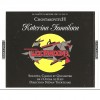
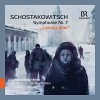

![Dmitri Shostakovich - Symphony No.7 [Mravinsky]](http://static.classicalm.com/repository/composition-cover/small/20753-img1409213833320472.jpg)
